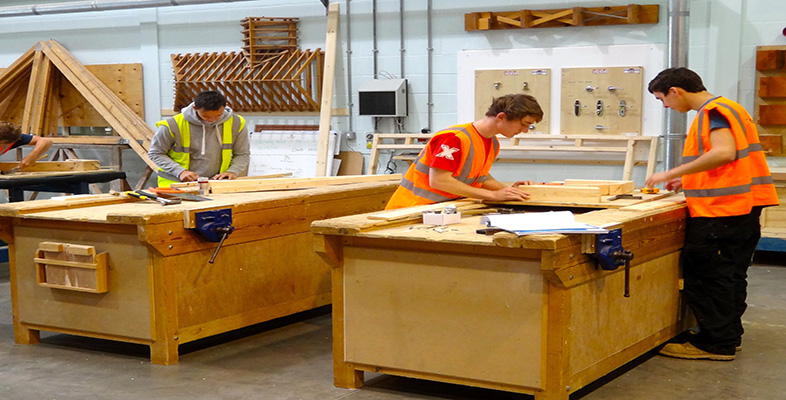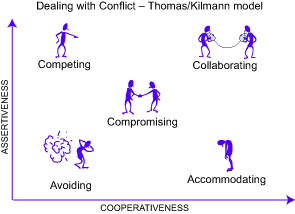2.1 Challenges in relationship building
There is a tendency to see conflict and differences of opinion as difficult and to be avoided; and yet one of the main ways in which we learn and grow is by coming into contact with new ideas and behaviours. When we are feeling strong, we may try these out for ourselves to see whether or not they work, yet at other times, we may feel threatened and either retreat from the conflict or lash out in exasperation. Young people also experience these emotions. The basic relationship-building skills: listening, conversing and observing can help you build the types of relationships with young people that can respond to such emotions, calm potential conflict and support young people’s development.
Working within the context of management and organisational development, Kenneth Thomas (1975) identified five styles for managing conflict:
Looking at these styles, you might be able to identify the one you use most and the skills you use to achieve these. In Thomas’s view, most people tend to lean towards one or other of these styles by the time they reach adulthood. However, he suggested that in fact what we need to do is develop the full range of styles and be flexible enough to know how to operate different styles in different situations and to recognise which style would be most appropriate. Therefore, here is a short description of each style which we hope gives you a starting point for developing ways of handling similar situations in your own work.
- Competing: People tend to behave as if they are sure they are right and are keen to make sure they win an argument, get their own way and achieve their own goals.
- Accommodating: The people using this style want to be liked. They tend to do what they think others want them to do.
- Avoiding: Those using this style usually try to avoid conflict at all costs. They may even try to avoid the people they anticipate conflict with, and not want to raise contentious issues. They hope that, by avoiding conflict, those issues will just disappear – although in fact the situation may get worse if the issues are not aired and resolved.
- Compromising: This approach involves some give and take – ‘I will do this for you if you will do that for me’.
- Collaborating: In this approach, people put their heads together to come up with a way of everybody getting what they want – what is known as a ‘win–win’ situation.
In terms of working with young people, the collaborative approach to conflict resolution is the one most likely to demonstrate that your attitude towards a young person is principled and respectful. Young people will recognise that you are taking them and their views most seriously when you listen to them and try and talk through new solutions to a problem together. We also need to recognise that there are times when we do have to tell young people how it is because they might be acting unsafely or doing something which is against the law. We are, after all, responsible for the safety of the young people we work with.
When you are trying to resolve conflict, you may take a different position to the young person, but listening carefully to what they are saying will help you identify common ground. Furthermore, if you involve others who can offer new perspectives on the situation, you are demonstrating that you are not being dogmatic, but are genuinely trying to find a solution that is acceptable to both of you. The ladder of collaboration below presents the five key steps in the collaborative process.
In the next activity, we want you to reflect on your own approach to managing conflict. You are also encouraged to get into the practice of reflective action for academic writing.
Activity 4 Thinking about managing conflict
Jot down examples of two situations when you dealt with conflict.
Then choose one of these conflict situations and write a brief outline of the situation. Explain:
- the style of conflict resolution you adopted, and why – do they relate to any of Kenneth Thomas’s styles?
- if you made a conscious decision to handle the situation in that particular way, or whether you were simply doing what you felt was right at the time
- why you think it worked well
- how you might you have handled it more productively overall.
Discussion
In conflicts, you can often separate the young person from the problem by demonstrating through your words and your body language that you respect them, even if you don’t like what they are doing. Feelings can get in the way of thinking. If the young person feels under threat, you are less likely to find a creative solution with them. It is also your professional duty to treat young people with respect. We should challenge the comments but never the young person. We also need to be polite – ‘I’ve noticed that you have been late three times now’, rather than ‘You’re such a pain in the neck, you’re always late’. You can also take the route of opening up the discussion rather than defining the problem yourself. Ask the young person what they think the problem actually is and find out if the young person has a possible solution.
You can use your listening skills to really identify the young person’s side of the argument. Keep an open mind about the outcomes, and keep using non-confrontational phrases such as ‘I’m not sure I understand that – could you explain what you mean?’ That way you can check that you have a proper understanding of their position and can clarify the problem.
If clarifying the problem hasn’t led to a breakthrough, it is time for both of you to contribute a range of alternative solutions to the decision-making process. If you can keep an open mind and your prejudices at bay, you may find that the person you are arguing with actually has a clearer idea of the issues and the solutions than you do. Even if this is not the case, your listening allows them to offload any anger or misery that may lie at the heart of the conflict. They will then be able to think more clearly, to feel valued and, therefore, more inclined to contribute to a discussion of the strengths and weaknesses of your different perspectives. You could also agree to collect information to shed more light on the matter. Agreeing on the outcomes together will enable you to work out a plan of action and for checking on progress towards them.


